Royal Air Force
The Royal Air Force (RAF) is the United Kingdom's aerial warfare force. It was formed towards the end of the First World War on 1 April 1918.[4] Following the Allied victory over the Central Powers in 1918, the RAF emerged as the largest air force in the world at the time.[5] Since its formation, the RAF has taken a significant role in British military history. In particular, it played a large part in the Second World War where it fought its most famous campaign, the Battle of Britain.[6]
| Royal Air Force | |
|---|---|
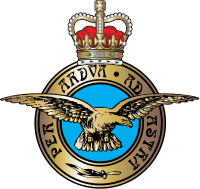 | |
| Founded | 1 April 1918 |
| Country | |
| Type | Air force |
| Role | Aerial warfare |
| Size | 33,840 active personnel[1] 832 operational aircraft[2] 1,940 RAuxAF 2,220 reserve personnel[lower-alpha 1] |
| Part of | British Armed Forces |
| Air Staff Offices | Whitehall, London |
| Motto(s) | Latin: Per Ardua ad Astra "Through Adversity to the Stars"[3] |
| March | Royal Air Force March Past |
| Website | www |
| Commanders | |
| Chief of the Air Staff | Air Chief Marshal Mike Wigston |
| Notable commanders | Lord Trenchard Lord Portal Lord Dowding |
| Insignia | |
| Ensign |  |
| Logo |  |
| Roundels | 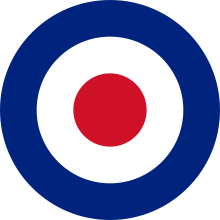  |
| Fin flashes |   |
| Pilot's Flying Badge | .jpg) |
| Aircraft flown | |
| Attack | |
| Fighter | |
| Trainer helicopter |
|
| Utility helicopter |
|
| Patrol | |
| Reconnaissance | |
| Trainer | |
| Transport | |
The RAF's mission is to support the objectives of the British Ministry of Defence (MoD), which are to "provide the capabilities needed to ensure the security and defence of the United Kingdom and overseas territories, including against terrorism; to support the Government's foreign policy objectives particularly in promoting international peace and security".[3] The RAF describes its mission statement as "... [to provide] an agile, adaptable and capable Air Force that, person for person, is second to none, and that makes a decisive air power contribution in support of the UK Defence Mission".[7] The mission statement is supported by the RAF's definition of air power, which guides its strategy. Air power is defined as "the ability to project power from the air and space to influence the behaviour of people or the course of events".[8]
Today the Royal Air Force maintains an operational fleet of various types of aircraft,[9] described by the RAF as being "leading-edge" in terms of technology.[10] This largely consists of fixed-wing aircraft, including: fighter and strike aircraft, airborne early warning and control aircraft, ISTAR and SIGINT aircraft, aerial refueling aircraft and strategic and tactical transport aircraft. The majority of the RAF's rotary-wing aircraft form part of the tri-service Joint Helicopter Command in support of ground forces. Most of the RAF's aircraft and personnel are based in the UK, with many others serving on operations (principally over Iraq and Syria) or at long-established overseas bases (Ascension Island, Cyprus, Gibraltar, and the Falkland Islands). Although the RAF is the principal British air power arm, the Royal Navy's Fleet Air Arm and the British Army's Army Air Corps also deliver air power which is integrated into the maritime, littoral and land environments.
History
Origins
While the British were not the first to make use of heavier-than-air military aircraft, the RAF is the world's oldest independent air force: that is, the first air force to become independent of army or navy control.[11] Following publication of the "Smuts report" prepared by Jan Smuts[12] the RAF was founded on 1 April 1918, with headquarters located in the former Hotel Cecil, during the First World War, by the amalgamation of the Royal Flying Corps (RFC) and the Royal Naval Air Service (RNAS). At that time it was the largest air force in the world. After the war, the service was drastically cut and its inter-war years were relatively quiet, with the RAF taking responsibility for the control of Iraq and executing a number of minor actions in other parts of the British Empire. The RAF's naval aviation branch, the Fleet Air Arm, was founded in 1924 but handed over to Admiralty control on 24 May 1939.[13]
The RAF developed the doctrine of strategic bombing which led to the construction of long-range bombers and became its main bombing strategy in the Second World War.[14]
Second World War
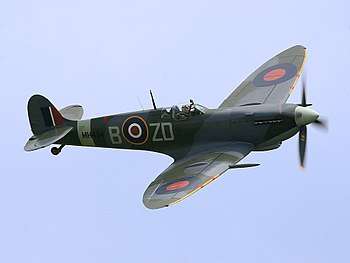
The RAF underwent rapid expansion prior to and during the Second World War. Under the British Commonwealth Air Training Plan of December 1939, the air forces of British Commonwealth countries trained and formed "Article XV squadrons" for service with RAF formations. Many individual personnel from these countries, and exiles from occupied Europe, also served with RAF squadrons. By the end of the war the Royal Canadian Air Force had contributed more than 30 squadrons to serve in RAF formations, similarly, approximately a quarter of Bomber Command's personnel were Canadian.[15] Additionally, the Royal Australian Air Force represented around nine percent of all RAF personnel who served in the European and Mediterranean theatres.[16]
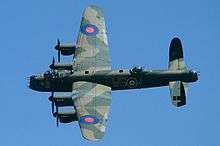
In the Battle of Britain in 1940, the RAF defended the skies over Britain against the numerically superior German Luftwaffe. In what is perhaps the most prolonged and complicated air campaign in history, the Battle of Britain contributed significantly to the delay and subsequent indefinite postponement of Hitler's plans for an invasion of the United Kingdom (Operation Sea Lion). In the House of Commons on 20 August, prompted by the ongoing efforts of the RAF, Prime Minister Winston Churchill eloquently made a speech to the nation, where he said "Never in the field of human conflict was so much owed by so many to so few".[17]
The largest RAF effort during the war was the strategic bombing campaign against Germany by Bomber Command. While RAF bombing of Germany began almost immediately upon the outbreak of war, under the leadership of Air Chief Marshal Harris, these attacks became increasingly devastating from 1942 onward as new technology and greater numbers of superior aircraft became available. The RAF adopted night-time area bombing on German cities such as Hamburg and Dresden, and developed precision bombing techniques for specific operations, such as the "Dambusters" raid by No. 617 Squadron,[18] or the Amiens prison raid known as Operation Jericho.[19]
Cold War era
Following victory in the Second World War, the RAF underwent significant re-organisation, as technological advances in air warfare saw the arrival of jet fighters and bombers. During the early stages of the Cold War, one of the first major operations undertaken by the Royal Air Force was in 1948 and the Berlin Airlift, codenamed Operation Plainfire. Between 26 June and the lifting of the Russian blockade of the city on 2 May, the RAF provided 17% of the total supplies delivered during the event, using Avro Yorks, Douglas Dakotas flying to Gatow Airport and Short Sunderlands flying to Lake Havel.[20]

Before Britain developed its own nuclear weapons the RAF was provided with American nuclear weapons under Project E. However following the development of its own arsenal, the British Government elected on 16 February 1960 to share the country's nuclear deterrent between the RAF and submarines of the Royal Navy, first deciding on 13 April to concentrate solely on the air force's V bomber fleet. These were initially armed with nuclear gravity bombs, later being equipped with the Blue Steel missile. Following the development of the Royal Navy's Polaris submarines, the strategic nuclear deterrent passed to the navy's submarines on 30 June 1969.[21] With the introduction of Polaris, the RAF's strategic nuclear role was reduced to a tactical one, using WE.177 gravity bombs. This tactical role was continued by the V bombers into the 1980s and until 1998 by Tornado GR1s.[22][23]
For much of the Cold War the primary role of the RAF was the defence of Western Europe against potential attack by the Soviet Union, with many squadrons based in West Germany. The main RAF bases in RAF(G) were RAF Bruggen, RAF Gutersloh, RAF Laarbruch and RAF Wildenrath – the only air defence base in RAF(G). With the decline of the British Empire, global operations were scaled back, and RAF Far East Air Force was disbanded on 31 October 1971.[24] Despite this, the RAF fought in many battles in the Cold War period. In June 1948 the RAF commenced Operation Firedog against Malayan terrorists during the Malayan Emergency.[25] Operations continued for the next 12 years until 1960 with aircraft flying out of RAF Tengah and RAF Butterworth. The RAF played a minor role in the Korean War, with flying boats taking part.[26] From 1953 to 1956 the RAF Avro Lincoln squadrons carried out anti-Mau Mau operations in Kenya using its base at RAF Eastleigh.[27] The Suez Crisis in 1956 saw a large RAF role, with aircraft operating from RAF Akrotiri and RAF Nicosia on Cyprus and RAF Luqa and RAF Hal Far on Malta as part of Operation Musketeer.[28]
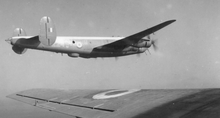
In 1957, the RAF participated heavily during Jebel Akhdar War in Oman with both Venom and Shackleton jet aircraft. The RAF made 1,635 raids, dropping 1,094 tons and firing 900 rockets at the interior of Oman between July and December 1958 targeting insurgents, mountain top villages and water channels in a war that remained under low profile.[29][30] The Konfrontasi against Indonesia in the early 1960s did see use of RAF aircraft, but due to a combination of deft diplomacy and selective ignoring of certain events by both sides, it never developed into a full-scale war.[31]
One of the largest actions undertaken by the RAF during the cold war was the air campaign during the 1982 Falklands War, in which the RAF operated alongside the Fleet Air Arm. During the war, RAF aircraft were deployed in the mid-Atlantic at RAF Ascension Island and a detachment from No. 1 Squadron was deployed with the Royal Navy, operating from the aircraft carrier HMS Hermes.[32][33] RAF pilots also flew missions using the Royal Navy's Sea Harriers in the air-to-air combat role, in particular Flt Lt Dave Morgan the highest scoring pilot of the war.[34] Following a British victory, the RAF remained in the South Atlantic to provide air defence to the Falkland Islands, based at RAF Mount Pleasant (built 1984).[35]
Recent history
With the end of the Cold War and the collapse of the Soviet Union, the RAF's focus has returned to expeditionary air power.[36] Since 1990 the RAF has been involved in several large-scale operations, including: the 1991 Gulf War,[37] the 1999 Kosovo War,[38] the 2001 War in Afghanistan,[39] the 2003 invasion and war in Iraq[40] and the 2011 intervention in Libya.[41]

The RAF's 90th anniversary was commemorated on 1 April 2008 by a flypast of 9 Red Arrows and four Typhoons along the Thames, in a straight line from just south of London City Airport Tower Bridge, the London Eye, the RAF Memorial and (at 13.00) the Ministry of Defence building.[42][43][44]
Four major defence reviews have been conducted since the end of the Cold War: the 1990 Options for Change, the 1998 Strategic Defence Review, the 2003 Delivering Security in a Changing World and the 2010 Strategic Defence and Security Review (SDSR). All four defence reviews have resulted in steady reductions in manpower and numbers of aircraft, especially combat aircraft such as fast-jets. As part of the latest 2010 Strategic Defence and Security Review, the BAE Systems Nimrod MRA4 maritime patrol aircraft was cancelled due to over spending and missing deadlines.[45] Other reductions saw total RAF manpower reduced by 5,000 personnel to a trained strength of 33,000 and the early retirement of the Joint Force Harrier aircraft, the Harrier GR7/GR9.[46]
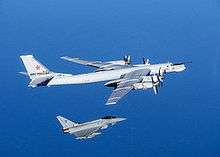
In recent years fighter aircraft on Quick Reaction Alert (QRA) have been increasingly required to scramble in response to efforts made by the Russian Air Force to approach British airspace.[48] On 24 January 2014 in the Houses of Parliament, Conservative MP and Minister of State for the Armed Forces, Andrew Robathan, announced that the RAF's QRA force had been scrambled almost thirty times in the last three years: eleven times during 2010, ten times during 2011 and eight times during 2012.[49]
RAF Coningsby in Lincolnshire and RAF Lossiemouth in Moray both provide Quick Reaction Alert, or QRA, and scramble their fighter jets within minutes to meet or intercept aircraft which give cause for concern. Lossiemouth generally covers the northern sector, while Coningsby provides QRA in the south. Typhoon pilot Flight Lieutenant Noel Rees describes how QRA duty works. "At the start of the scaled QRA response, civilian air traffic controllers might see on their screens an aircraft behaving erratically, not responding to their radio calls, or note that it's transmitting a distress signal through its transponder. Rather than scramble Typhoons at the first hint of something abnormal, a controller has the option to put them on a higher level of alert, 'a call to cockpit'. In this scenario the pilot races to the hardened aircraft shelter and does everything short of starting his engines".[50]
On 4 October 2015, a final stand-down saw the end of more than 70 years of RAF Search and Rescue provision in the UK. The RAF and Royal Navy's Westland Sea King fleets, after over 30 years of service, were retired. A civilian contractor, Bristow Helicopters, took over responsibility for UK Search and Rescue, under a Private Finance Initiative with newly purchased Sikorsky S-92 and AgustaWestland AW189 aircraft. The new contract means that all UK SAR coverage is now provided by Bristow aircraft.[51]
In 2018 the RAF's vision of a future constellation of imagery satellites was initiated through the launch of the Carbonite-2 technology demonstrator. The 100 kg Carbonite-2 uses commercial off-the-shelf (COTS) components to deliver high-quality imagery and 3D video footage from space.[52][53]
Structure
 |
| Royal Air Force air component of the British Armed Forces |
|---|
| Components |
|
| History |
|
|
| Aircraft |
|
| Structure |
| Personnel |
Senior management
The professional head and highest-ranking officer of the Royal Air Force is the Chief of the Air Staff (CAS). He reports to the Chief of the Defence Staff, who is the professional head of the British Armed Forces.[54] The incumbent Chief of the Air Staff is Air Chief Marshal Mike Wigston, who was appointed in July 2019.[55]
The management of the RAF is the responsibility the Air Force Board, a sub-committee of the Defence Council which is part of the Ministry of Defence and body legally responsible for the defence of the United Kingdom and its overseas territories. The Chief of the Air Staff chairs the Air Force Board Standing Committee (AFBSC) which decides on the policy and actions required for the RAF to meet the requirements of the Defence Council and Her Majesty's Government.[56]
The Chief of the Air Staff is supported by several other senior commanders, the main positions are shown in the following table.[57]
| Title | Rank | NATO Rank |
|---|---|---|
| Chief of the Air staff | Air Chief Marshal | OF-9 |
| Deputy Commander Capability | Air Marshal | OF-8 |
| Deputy Commander of Operations | Air Marshal | OF-8 |
| Air Member for Materiel and Chief of Materiel | Air Marshal | OF-8 |
| Assistant Chief of the Air Staff | Air Vice-Marshal | OF-7 |
| Chief of Staff Personnel and Air Secretary | Air Vice-Marshal | OF-7 |
| Commandant General Royal Auxiliary Air Force | Air Vice-Marshal | OF-7 |
| Director of Legal Services | Air Vice-Marshal | OF-7 |
| Chaplain-in-Chief | Air Vice-Marshal | OF-7 |
| Director of Resources | N/A (Civilian) | N/A |
| Chief of the Air Staff's Warrant Officer | Warrant Officer | OR-9 |
Air Command
Administrative and operational command of the RAF is delegated by the Air Force Board to Headquarters Air Command, based at RAF High Wycombe in Buckinghamshire. Air Command was formed on 1 April 2007 by combining RAF Strike Command and RAF Personnel and Training Command, resulting in a single command covering the whole RAF, led by the Chief of the Air Staff.[58] Through its subordinate groups, Air Command oversees the whole spectrum of RAF aircraft and operations.[59]
Groups
Groups are the subdivisions of operational commands and are responsible for certain types of capabilities or for operations in limited geographical areas. There are six groups subordinate to Air Command, of which five are functional and one is geographically focused:
No. 1 Group (Air Combat)
No. 1 Group is responsible for combat aircraft (comprising the Lightning Force & Typhoon Force) and the RAF's intelligence, surveillance, target acquisition, and reconnaissance (ISTAR) capabilities. It oversees stations at RAF Coningsby and RAF Waddington in Lincolnshire, RAF Lossiemouth in Moray and RAF Marham in Norfolk. The group's Eurofighter Typhoon FGR4 aircraft protect UK and NATO airspace by providing a continuous Quick Reaction Alert capability.[60]
No. 2 Group (Air Combat Support)
No. 2 Group controls the Air Mobility Force which provides strategic and tactical airlift, air-to-air refuelling and Command Support Air Transport. The group is also responsible for the RAF's Force Protection assets comprising the RAF Regiment and RAF Police. It oversees stations at RAF Benson and RAF Brize Norton in Oxfordshire, RAF Henlow in Bedfordshire, RAF Honington in Suffolk, RAF Odiham in Hampshire and RAF Northolt in West London.[61]
No. 11 Group (Multi-domain operations)
No. 11 Group is responsible for integrating operations across the air, cyber and space domains whilst responding to new and evolving threats. It includes the RAF's Battlespace Management Force which controls the UK Air Surveillance and Control System (ASACS). The group oversees stations at RAF Boulmer in Northumberland, RAF Fylingdales in North Yorkshire, RAF Scampton in Lincolnshire and RAF Spadeadam in Cumbria.[62]
No. 22 Group (Training)
No. 22 Group is responsible for the supply of qualified and skilled personnel to the RAF and provides flying and non-flying training to all three British armed services. It is the end-user of the UK Military Flying Training System which is provided by civilian contractor Ascent Flight Training. The group oversees stations at RAF College Cranwell in Lincolnshire, RAF Cosford and RAF Shawbury in Shropshire, RAF Halton in Buckinghamshire, MOD St Athan in the Vale of Glamorgan, RAF St Mawgan in Cornwall and RAF Valley on Angelsey.[63]
No. 38 Group (Air Combat Service Support)
No. 38 Group is responsible for RAF capabilities relating to engineering and logistics (known as the A4 Force, in accordance with the continental staff system), communications, medical operations and RAF Music services. It is responsible for UK-based US Visiting Forces and for RAF personnel detached within foreign armed forces around the globe. The group oversees stations at RAF High Wycombe in Buckinghamshire and RAF Wittering in Cambridgeshire.[64]
No. 83 Expeditionary Air Group
No. 83 Expeditionary Air Group (No. 83 EAG) is the RAF's operational headquarters in the Middle East, based at Al Udeid Air Base in Qatar. It is responsible for UK air operations in the Persian Gulf and Indian Ocean (Operation Kipion), the military intervention against the Islamic State of Iraq and the Levant (Operation Shader) and wider UK defence objectives in the Middle East. Operations are delivered through four Expeditionary Air Wings (No. 901 EAW, No. 902 EAW, No. 903 EAW and No. 904 EAW).[65]
Stations
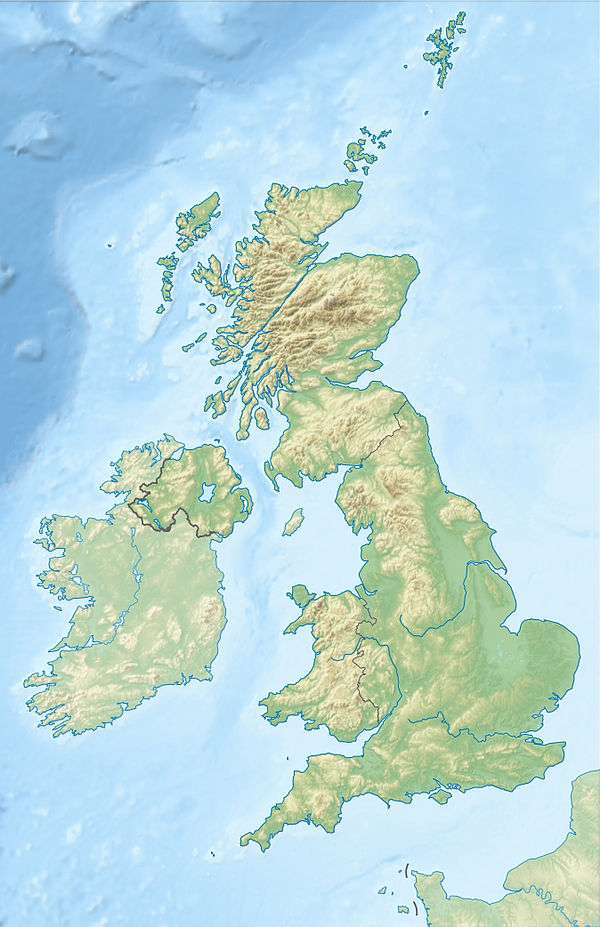
An RAF station is ordinarily subordinate to a group and is commanded by a group captain. Each station typically hosts several flying and non-flying squadrons or units which are supported by administrative and support wings.[66]
United Kingdom
Front-line flying operations are focussed at eight stations:[67]
- RAF Coningsby, RAF Marham and RAF Lossiemouth (Air Combat)
- RAF Waddington (Intelligence, Surveillance Target Acquisition and Reconnaissance (ISTAR))
- RAF Brize Norton and RAF Northolt (Air Transport)
- RAF Benson and RAF Odiham (Support Helicopter Force operating under Joint Helicopter Command)
Flying training takes places at RAF Barkston Heath, RAF College Cranwell, RAF Shawbury and RAF Valley, each forming part of the UK Military Flying Training System which is dedicated to training aircrew for all three UK armed services. Specialist ground crew training is focused at RAF Cosford, RAF St Mawgan and MOD St. Athan.
Operations are supported by numerous other flying and non-flying stations, with activity focussed at RAF Honington which coordinates Force Protection and RAF Leeming & RAF Wittering which have a support enabler role.
A Control and Reporting Centre (CRC) at RAF Boulmer is tasked with compiling a Recognised Air Picture of UK air space and providing tactical control of the Quick Reaction Alert Force. In order to achieve this Boulmer is supported by a network of eight Remote Radar Heads (RRHs) spread the length of the UK.[68]
Overseas
The UK operates permanent military airfields (known as Permanent Joint Operating Bases) in four British Overseas Territories. These bases contribute to the physical defence and maintenance of sovereignty of the British Overseas Territories and enable the UK to conduct expeditionary military operations.[69] Although command and oversight of the bases is provided by Strategic Command, the airfield elements are known as RAF stations.[70]
- RAF Akrotiri (Sovereign Base Areas of Akrotiri and Dhekelia, Cyprus)
- RAF Ascension Island (Saint Helena, Ascension and Tristan da Cuhna)
- RAF Mount Pleasant (Falkland Islands)
- RAF Gibraltar (Gibraltar)
Two RAF squadrons are located within the United States to support close cooperation with the US Air Force in the operation of the MQ-9A Reaper (Creech Air Force Base, Nevada) and development of the F-35A Lighting II (Edwards Air Force Base, California).[71]
Squadrons
A flying squadron is an aircraft unit which carries out the primary tasks of the RAF. RAF squadrons are somewhat analogous to the regiments of the British Army in that they have histories and traditions going back to their formation, regardless of where they are based, which aircraft they are operating, etc. They can be awarded standards and battle honours for meritorious service. Whilst every squadron is different, most flying squadrons are commanded by a wing commander and, for a fast-jet squadron, have an establishment of around 12 aircraft.[72]
Support wings and units
Support capabilities are provided by several specialist wings and other units.
- Air Warfare Centre (RAF Waddington)
- Airborne Delivery Wing (RAF Brize Norton)
- Mobile Meteorological Unit
- Tactical Communications Wing (RAF Leeming)
- Tactical Medical Wing (RAF Brize Norton)
- Tactical Supply Wing (MOD Stafford)
- No. 1 Air Control Centre (RAF Scampton)
- No. 1 Air Mobility Wing (RAF Brize Norton)
- No. 1 Intelligence, Surveillance and Reconnaissance Wing (RAF Waddington)
- No. 42 (Expeditionary Support) Wing (RAF Wittering)
- No. 85 (Expeditionary Logistics) Wing (RAF Wittering)
- No. 90 Signals Unit (RAF Leeming)
Expeditionary Air Wings
Command & control and support for overseas operations is typically provided through Expeditionary Air Wings (EAWs). Each wing is brought together as and when required and comprises the deployable elements of its home station as well as other support elements from throughout the RAF.[73]
- No. 34 Expeditionary Air Wing (RAF Waddington) – ISTAR operations[74]
- No. 38 Expeditionary Air Wing (RAF Brize Norton) – air transport operations[75]
- No. 121 Expeditionary Air Wing (RAF Coningsby) – multi-role operations[76]
- No. 135 Expeditionary Air Wing (RAF Leeming) – fighter operations[76]
- No. 138 Expeditionary Air Wing (RAF Marham) – fighter operations[76]
- No. 140 Expeditionary Air Wing (RAF Lossiemouth) – fighter operations[76]
Several Expeditionary Air Wings are based overseas:[65]
- No. 901 Expeditionary Air Wing (Al Udeid Air Base, Qatar) – Communication and information systems support
- No. 902 Expeditionary Air Wing (Middle East) – Helicopter support
- No. 903 Expeditionary Air Wing (RAF Akrotiri, Cyprus) – Supports Operation Shader
- No. 905 Expeditionary Air Wing (RAF Mount Pleasant, Falklands Islands) – Protection of British Overseas Territories in the South Atantic
- No. 906 Expeditionary Air Wing (Middle East) – Air transport support
Training Schools
The RAF Schools consist of the squadrons and support apparatus that train new aircrew to join front-line squadrons. The schools separate individual streams, but group together units with similar responsibility or that operate the same aircraft type. Some schools operate with only one Squadron, and have an overall training throughput which is relatively small; some, like 3 FTS, have responsibility for all Elementary Flying Training (EFT) in the RAF, and all RAF aircrew will pass through its squadrons when they start their flying careers. 2 FTS and 6 FTS do not have a front-line training responsibility – their job is to group the University Air Squadrons and the Volunteer Gliding Squadrons together. 2 FTS's commanding officer holds the only full-time flying appointment for a Group Captain in the RAF, and is a reservist.
- Central Flying School – CFS standardises flying training across the air force and ensures standards and safety are maintained.[77]
- No. 1 Flying Training School - formerly the Defence Helicopter Flying School – Basic helicopter training, based at RAF Shawbury.[78][79]
- No. 2 Flying Training School – Gliding training, based at RAF Syerston[80]
- No. 3 Flying Training School – Elementary Flying Training, based at RAFC Cranwell with a squadron at RAF Wittering.[81] (incorporates the former Defence Elementary Flying Training School – Elementary Flying Training for Royal Navy and Army Air Corps students, based at RAF Barkston Heath[82])
- No. 4 Flying Training School – Basic Fast Jet Training (BFJT) and Advanced Fast Jet Training (AFJT), based at RAF Valley[83]
- No. 6 Flying Training School – Flight training for the University Air Squadrons, based at RAF stations throughout the UK[84]
The British military operate a number of joint training organisations with Air Command leading the provision of technical training through the Defence College of Technical Training[85] – Several different specialist areas: aeronautical engineering, electro and mechanical engineering, and communication and information systems.[86]
- Defence College of Aeronautical Engineering.[87] Comprising:
- Royal Naval Air Engineering and Survival Equipment School.
- DCAE (Lyneham)
- No 1 School of Technical Training, Royal Air Force
- Defence College of Electro-Mechanical Engineering.[88] Comprising:
- Royal Naval School of Marine Engineering
- 8 Battalion Royal Electrical and Mechanical Engineers
- No 4 School of Technical Training, Royal Air Force
- Defence School of Communications and Information Systems.[89] Comprising:
- 11th (Royal School of Signals) Signal Regiment
- No 1 Radio School, Royal Air Force
- Defence School of Marine Engineering.
Flights
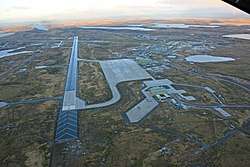
A flight is a sub-division of a squadron. Flying squadrons are often divided into two flights, e.g., "A" and "B", each under the command of a squadron leader. Administrative squadrons on a station are also divided into flights and these flights are commanded by a junior officer, often a flight lieutenant. Because of their small size, there are several flying units formed as flights rather than squadrons. For example, No. 1435 Flight is based at RAF Mount Pleasant in the Falkland Islands, maintaining air defence cover with four Eurofighter Typhoon aircraft.[90]
Personnel
_(2).jpg)
At its height in 1944 during the Second World War, more than 1,100,000 personnel were serving in the RAF. The longest-lived founding member of the RAF was Henry Allingham, who died on 18 July 2009 aged 113.[91]
As of 1 January 2015, the Royal Air Force numbered some 34,200 Regular[92] and 1,940 Royal Auxiliary Air Force[93] personnel, giving a combined component strength of 36,140 personnel. In addition to the active elements of the Royal Air Force, (Regular and Royal Auxiliary Air Force), all ex-Regular personnel remain liable to be recalled for duty in a time of need, this is known as the Regular Reserve. In 2007 there were 33,980 Regular Reserves of the Royal Air Force, of which 7,950 served under a fixed-term reserve contract.[94] Publications since April 2013 no-longer report the entire strength of the Regular Reserve, instead they only give a figure for Regular Reserves who serve under a fixed-term reserve contract.[95] They had a strength of 7,120 personnel in 2014.[96]
Figures provided by the International Institute for Strategic Studies from 2012 showed that Royal Air Force pilots achieve a relatively high number of flying hours per year when compared with other major NATO allies such as France and Germany. RAF pilots achieve 210 to 290 flying hours per year.[97] French and German Air Force pilots achieved only 180 and 150 flying hours across their fleets respectively.[98]
Officers
Officers hold a commission from the Sovereign, which provides the legal authority for them to issue orders to subordinates. The commission of a regular officer is granted after successfully completing the 24-week-long Initial Officer Training course at the RAF College, Cranwell, Lincolnshire.[99]
To emphasize the merger of both military and naval aviation when the RAF was formed, many of the titles of officers were deliberately chosen to be of a naval character, such as flight lieutenant, wing commander, group captain, and air commodore.[100]
Other ranks
Other ranks attend the Recruit Training Squadron at RAF Halton for basic training.[101] The titles and insignia of other ranks in the RAF were based on that of the Army, with some alterations in terminology. Over the years, this structure has seen significant changes: for example, there was once a separate system for those in technical trades, and the ranks of chief technician and junior technician continue to be held only by personnel in technical trades. RAF other ranks fall into four categories: Warrant Officers, Senior Non-Commissioned Officers, Junior Non-Commissioned Officers and Airmen. All Warrant Officers in the RAF are equal in terms of rank, but the most senior Non-Commissioned appointment is known as the Chief of the Air Staff's Warrant Officer.[102]
Specialist training and education
The Royal Air Force operates several units and centres for the provision of non-generic training and education. These include the Royal Air Force Leadership Centre and the Royal Air Force Centre for Air Power Studies, both based at RAF Cranwell,[103] and the Air Warfare Centre, based at RAF Waddington and RAF Cranwell.[104] NCO training and developmental courses occur at RAF Halton and officer courses occur at the Joint Services Command and Staff College at Shrivenham.[105]
Aircraft
Combat Air
Typhoon
The Eurofighter Typhoon FGR4 is the RAF's primary multi role air defence and ground attack fighter aircraft,[106][107] following the retirement of the Panavia Tornado F3 in late March 2011.[108] With the completion of 'Project Centurion' upgrades, the Typhoon FGR4 took over ground attack duties from the Panavia Tornado GR4, which was retired on 1 April 2019.[109][110][111] The Typhoon is tasked to defend UK airspace, while also frequently deploying in support of NATO air defence missions in the Baltic (Operation Azotize), Black Sea and Iceland.[106][112]
The RAF has seven front-line Typhoon units, plus an Operational Conversion Unit and Operational Evaluation Unit; No. 3 (Fighter) Squadron, No. XI (F) Squadron, No. 12 Squadron (joint RAF/Qatar Air Force squadron), No. 29 Squadron (OCU) and No. 41 Test and Evaluation Squadron (OEU) based at RAF Coningsby, with No. 1 (F) Squadron, No. II (Army Cooperation) Squadron, No. 6 Squadron and No. IX (Bomber) Squadron based at RAF Lossiemouth.[106][113] Four Typhoons (Faith, Hope, Charity and Desperation) are also based at RAF Mount Pleasant on the Falkland Islands as part of No. 1435 Flight where they provide air defence.[114] As of 2020, the option of an eighth front-line squadron is being studied.[115]
In October 2007, it was announced that MoD Boscombe Down, RNAS Culdrose and RAF Marham would also be used as Quick Reaction Alert bases from early 2008, offering around-the-clock fighter coverage for the South and South West of UK airspace when a direct threat has been identified.[116] The Typhoon made its combat debut in support of Operation Ellamy in 2011 and has been supporting Operation Shader since December 2015.[106]
Lightning
On 23 November 2015, it was announced that a total of 138 Lockheed Martin F-35B Lightning IIs will be ordered.[117][118][119] Known only as the Lightning in British service,[120] the first RAF squadron to operate the F-35 was No. 17 Test and Evaluation Squadron at Edwards AFB, California, accepting its first F-35B in 2014.[121] No. 617 (The Dambusters) Squadron officially reformed on 18 April 2018 as an RAF Lightning Squadron.[122] The first four aircraft arrived at RAF Marham in June 2018,[123] with a further five arriving in August 2018.[124] The planes were declared combat ready in January 2019.[125] The second UK based F-35 squadron to be formed was No. 207 Squadron on 1 August 2019 as the OCU for both RAF and Royal Navy pilots.[126][127]
Intelligence, Surveillance, Target Acquisition, and Reconnaissance (ISTAR)
The Boeing E-3D Sentry AEW1, based at RAF Waddington and operated by No. 8 Squadron,[128] provides airborne early warning to detect incoming enemy aircraft and to co-ordinate the aerial battlefield.[129] Six E-3 aircraft were originally procured in February 1987, with an additional Sentry ordered later that year.[130] Deliveries to the RAF were completed in 1992, when ZH107 was handed over in May.[131] The 2015 SDSR planned for six Sentry AEW1s to remain in service until 2035.[132] However, the UK Government's announcement of the procurement of five Boeing E-7 Wedgetails in March 2019 led to the withdrawal of two Sentry AEW1s in preparation for the future transition to the new type, bringing the fleet down to four aircraft.[133] In February 2020, it was announced that another E-3D had been retired in January, with the OSD (out of service date) for the Sentry being brought forward to December 2022 – before the E-7 Wedgetail will enter service.[134]
The Raytheon Sentinel R1 (formally known as ASTOR – Airborne STand-Off Radar) provides a ground radar-surveillance platform based on the Bombardier Global Express long range business jet, and is flown by No. V (AC) Squadron from RAF Waddington.[135] Originally ordered in 1999,[136] the Sentinel entered into RAF service in 2008.[137] The fifth and final Sentinel R1 ZJ694 was delivered in February 2009 to RAF Waddington.[138] In the 2010 SDSR, it was announced that the Sentinel would be withdrawn once operations in Afghanistan had been concluded.[139] In July 2014, these plans were reversed to keep the Sentinel in service until 2018.[140] In July 2017, ZJ693 was withdrawn from service while the rest of the Sentinel fleet was given an OSD of 2021.[141]
Six Hawker Beechcraft Shadow R1s (with two more to be converted) are operated by No. 14 Squadron from RAF Waddington, these aircraft are King Air 350CERs that have been specially converted for the ISTAR role.[142] Four Shadow R1s were originally ordered in 2007 due to an Urgent Operational Requirement,[143] and began the conversion process to the ISTAR role in 2009.[144] ZZ416 was the first Shadow R1 to be delivered in May 2009 to No. V (AC) Squadron.[145] A further Shadow was procured and delivered in December 2011.[146] The Shadow fleet was transferred over to the newly reformed No. 14 Squadron in October 2011.[147] Following the 2015 SDSR, three more Shadows were ordered and the fleet was given an OSD of 2030.[148]
Ten General Atomics MQ-9A Reaper Unmanned aerial vehicles have been purchased to support operations in Iraq and Afghanistan. They are operated by No. 39 Squadron based at Creech Air Force Base and No. XIII Squadron at RAF Waddington.[149]
Three Boeing RC-135W Rivet Joints replaced the Nimrod R1 fleet in the signals intelligence role under the AIRSEEKER Programme and are flown by No. 51 Squadron.[150] The Nimrod fleet was retired in 2011, the RAF co-manned aircraft of the US Air Force until the three RC-135s entered service between 2014 and 2017.[151] The aircraft were Boeing KC-135R Stratotanker tankers converted to RC-135W standard in the most complex combined Foreign Military Sales case and co-operative support arrangement that the UK had undertaken with the United States Air Force since the Second World War.[152] Airseeker received its first operational deployment in August 2014, when it was deployed to the Middle East to fly missions over Iraq and Syria as part of Operation Shader.[153]
Based at RAF Waddington, No. 54 Squadron and No. 56 Squadron act as the OCU and OEU for the ISTAR fleet respectively.[154][155]
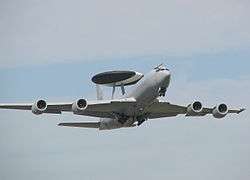


_Sqdn_RAF_Waddington_this_morning.jpg)
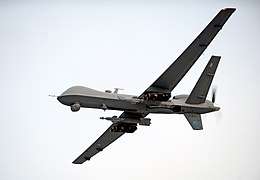 MQ-9A Reaper
MQ-9A Reaper
Helicopters
An important part of the work of the RAF is to support the British Army by moving troops and equipment to and around the battlefield. RAF helicopters are also used in a variety of other roles, including in support of RAF ground units and heavy-lift support for the Royal Marines. The support helicopters are organised into the tri-service Joint Helicopter Command (JHC), along with helicopters from the British Army and Royal Navy.[156] No. 22 Squadron, based at RAF Benson, re-formed in May 2020 as the OEU for the JHC.[157]
The large twin-rotor Boeing Chinook is the RAF's heavy-lift support helicopter.[158] Originally ordered in 1978,[159] with subsequent orders in 1995,[160] 2011,[161] and 2018 (yet to be finalised),[162] the Chinook is operated by Nos. 7, 18(B) and 27 Squadrons at RAF Odiham and No. 28 Squadron (Support Helicopter OCU) at RAF Benson.[163] Since being first delivered in 1981, the Chinook has been involved in numerous operations: the Falklands War (1982); Operation Granby (1991); Operation Engadine (1999); Operation Barras (2000); Operation Herrick (2002–2014); Operation Telic (2003–2011); Operation Ruman (2017); and Operation Newcombe (2018–present).[163][164][165][166] The 60-strong fleet of Chinooks currently has an OSD in the 2040s.[167][168]
The Westland Puma HC2 is the RAF's Medium-lift support helicopter. It is operated by No. 33 Squadron and No. 230 Squadron (the RAF's Tiger Squadron)[169], as well as by No. 28 Squadron (Support Helicopter OCU), all of which are based at RAF Benson.[170] The first two Puma HC1s (XW198 and XW199), of an eventual 48, were delivered in January 1971,[171] which were supplemented by a captured Argentine Army SA 330J in 2001 and six ex-South African Air Force SA 330Ls in 2002.[172][173] 24 of the Puma HC1s underwent upgrades to HC Mk.2 standard between 2012 and 2014.[174] The Puma HC2 OSD is currently set to be March 2025.[175]
Three Bell Griffin HAR.2s of No. 84 Squadron are based at RAF Akrotiri in the Cyprus Sovereign Base Areas.[176] They are the RAF's only dedicated helicopter Search and Rescue force since the disbandment of the RAF Search and Rescue Force in February 2016.[177] However, all UK military helicopter aircrew routinely train and practice the skills necessary for Search and Rescue, and the support helicopters based in the UK are available to the Government under Military Aid to the Civil Authorities in case they are needed.[178]
The AgustaWestland AW109 Grand New aircraft of No. 32 (The Royal) Squadron also provide VIP transport and military helicopter capabilities.[179]
Maritime
Nine Boeing Poseidon MRA1s[180] were ordered by the Government in November 2015 in its Strategic Defence and Security Review for surveillance, anti-submarine and anti-surface ship warfare, filling a capability gap in maritime patrol that had been left since the cancellation of the BAE Systems Nimrod MRA4 programme in the 2010 SDSR.[181] On 13 July 2017, it was announced that No. 120 Squadron and No. 201 Squadron, both former Nimrod MR2 squadrons, would be the two units to operate the P-8A Poseidon, based at RAF Lossiemouth.[182] No. 120 Squadron stood up on 1 April 2018, with No. 201 Squadron set to form sometime in 2021.[182] The first production Poseidon MRA1 ZP801 made its initial flight on 13 July 2019.[183] ZP801 arrived at Kinloss Barracks, the former home of the Nimrod, on 4 February 2020, filling a decade long gap in maritime capability.[184]
Air Mobility
The RAF operate the Boeing C-17 Globemaster III in the heavy strategic airlift role, originally leasing four from Boeing. These four were subsequently purchased outright, followed by a fifth delivered on 7 April 2008 and a sixth delivered on 11 June 2008. The new aircraft entered frontline use within days. The MoD said there was "a stated departmental requirement for eight" C-17s and a seventh was subsequently ordered, to be delivered in December 2010.[185] In February 2012 the purchase of an eighth C-17 was confirmed;[186] the aircraft arrived at RAF Brize Norton in May 2012.[187]
Air transport tasks are also carried out by the Airbus A330 MRTT, known as the Voyager in RAF service. The first Voyager arrived in the UK for testing at MoD Boscombe Down in April 2011,[188] and entered service in April 2012.[189] The Voyager received approval from the MoD on 16 May 2013 to begin air-to-air refuelling flights and made its first operational tanker flight on 20 May 2013 as part of a training sortie with Tornado GR4s. By 21 May 2013, the Voyager fleet had carried over 50,000 passengers and carried over 3,000 tons of cargo.[190] A total of 14 Voyagers form the fleet, with nine allocated to sole RAF use (three KC2s and six KC3s).[191] As the Voyagers lack a refueling boom, the RAF has requested a memorandum of understanding (MoU) with the USAF allowing the UK access to tankers equipped with refueling booms for its Boeing RC-135W Airseeker SIGINT aircraft.[192]
Shorter range, tactical-airlift transport is provided by the Lockheed Martin C-130J Hercules, known as the Hercules C4 (C-130J-30) and Hercules C5 (C-130J) in RAF service, based at RAF Brize Norton in Oxfordshire. The draw-down of the Hercules C5 fleet has begun with the final aircraft planned to retire in 2019. The fourteen C4 extended variants are scheduled to retire on 31 March 2035. However, due to the crash of Hercules C4 ZH873 in August 2017,[193] one Hercules C5 will be retained to keep the fleet at 14 aircraft.[194] The Airbus Atlas C1 (A400M) replaced the RAF's fleet of Hercules C1/C3 (C-130K) transport aircraft which were withdrawn from service on 31 December 2012. The A400M is also expected to replace the C4/C5 variants. Originally, 25 A400Ms were ordered; the total purchase has now dropped to 22.[195][196]
No. 32 (The Royal) Squadron replaced the Queen's Flight in 1995 and operate the Agusta A109 and BAe 146 CC2 in the general air transport and VIP transport roles. The squadron is based at RAF Northolt in west London. Aircraft operate with a priority for military needs over VIP transport. Two additional BAe 146s were purchased in March 2012 from TNT Airways and were refitted by Hawker Beechcraft on behalf of BAE Systems for tactical freight and personnel transport use.[197][198] The aircraft, designated as the BAe 146 C Mk 3, arrived in Afghanistan in April 2013.[199]
 C-17A Globemaster III
C-17A Globemaster III
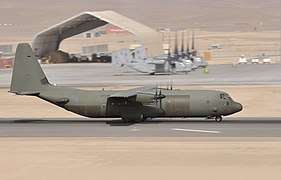 Hercules C4 (C-130J-30)
Hercules C4 (C-130J-30).jpg)
.jpg) BAe 146 CC2
BAe 146 CC2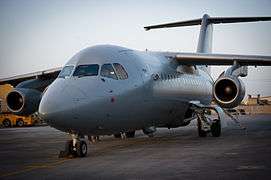 BAe 146 C3
BAe 146 C3
Training aircraft
Elementary Flying Training (EFT), as well as Multi-Engine Lead-In training, is conducted on the Grob Prefect T1.[200] Basic fast jet training is provided on the Beechcraft Texan T1, replacing the Short Tucano T1 in November 2019, and initial helicopter training on the Squirrel HT1. Multi-Engine aircrew, weapon systems officer (WSO) and weapon systems operator (WSOp) students are trained on the Embraer Phenom T1. On completion of these stages of training, aircrew are awarded their 'wings' badge to wear on their uniforms, and multi-engine aircrew then go to their Operational Conversion Unit. Fast jet aircrew proceed to Advanced training on BAe Hawk T2, while helicopter aircrew complete a course on the Bell Griffin HT1, before going on to an Operational Conversion Unit (OCU). Each OCU trains aircrew on a specific aircraft type in preparation for service with a front-line squadron. The OCUs mainly use operational aircraft, though some training variants exists, such as the Typhoon T3, as well as sophisticated simulators and ground training.[201]
The Tutor equips the fourteen University Air Squadrons, which provide University students an opportunity to undertake an RAF training syllabus based loosely on EFT, which includes first solo, as well as air navigation, aerobatics and formation flying. These units are co-located with Air Experience Flights, which share the same aircraft and facilities and provide air experience flying to the Air Training Corps and CCF. The Volunteer Gliding Squadrons also provide air experience flying to cadets using the Grob Viking T1 conventional glider. Due to an airworthiness issue in April 2014, the Viking fleet and the Grob Vigilant T1 aircraft were grounded for a two-year period, although Viking operations have subsequently resumed.[202] The Vigilant was unexpectedly withdrawn from service in May 2018, a year earlier than planned. A contract tender was initiated in February 2018 to replace this capability from 2022 onwards.[203]
Two of the ten T-6 Texan II trainers due as part of the UK Military Flight Training System were delivered in February 2018, forming the nucleus of the unit to be operated at RAF Valley. The aircraft are jointly operated by the Royal Air Force and Ascent Flight Training to provide lead-in training for RAF and Royal Navy fighter pilots prior to advanced training on the Hawk.[204]
The BAe Hawk T1, as well as being flown by the Red Arrows, is also flown by No. 100 Squadron to support other fast jet and ground unit training, as an aggressor aircraft. The Squadron fulfills the role of enemy aircraft in air combat training or to provide additional air assets in joint exercises.[205]
- Tutor T1
.jpg)
.jpg) Hawk T1
Hawk T1.jpg)

.jpg)
Future aircraft
The F-35B Lightning II is intended to enter service around 2020 under the Joint Combat Aircraft programme.[206] On 19 July 2012 the Defence Secretary, Philip Hammond, in a speech in the US, indicated that the UK would initially receive 48 F-35B to equip the Navy's carrier fleet and would announce at a later date what the final numbers would be. Jon Thompson, MOD Permanent Secretary, told the House of Commons Defence Select Committee, in late 2012: "Our commitment over the first 10 years is for 48 F-35B". An order for the first 14 aircraft on top of the four already procured for operational test and evaluation is expected later in 2013. The first four of 14 production aircraft were ordered in November 2014.[207] Six further aircraft were ordered on 3 November 2015,[207] with expected delivery in 2016. In November 2015, the government commitment to order 48 F-35B aircraft by 2023,[208] 24 of which will be available for carrier duties.[148] The 2015 Strategic Defence and Security Review stated the intent for the UK to purchase 138 F-35 aircraft over the life of the programme.[148] The first F-35 aircraft arrived at RAF Fairford in Gloucestershire on 29 June 2016 after a Transatlantic crossing involving air to air refuelling.[209]
On 5 October 2015, it was announced that the Scavenger programme had been replaced by "Protector", a new requirement for at least 20 systems.[210] On 7 October 2015, it was revealed that Protector will be a Certifiable derivative of the MQ-9B SkyGuardian with enhanced range and endurance.[211] In 2016 it was indicated that at least 16 UAVs would be purchased with a maximum of up to 26.[212] In July 2018, a General Atomics US Civil registered MQ-9B SkyGuardian was flown from North Dakota to RAF Fairford for the Royal International Air Tattoo where it was given RAF markings. It was formally announced by the Chief of Air Staff that No. 31 Squadron would become the first squadron to operate the Protector RG1.[213][214][215]
In July 2014, the House of Common Defence Select Committee released a report on the RAF future force structure that envisaged a mixture of unmanned and manned platforms, including further F-35, Protector RG1, a service life extension for the Typhoon (which would otherwise end its service in 2030) or a possible new manned aircraft.[216]
In July 2018, at the Farnborough Airshow, the Defence Secretary announced a £2bn investment for BAe Systems, MBDA and Leonardo to develop a new British 6th Generation Fighter to replace Typhoon in 2035 under Project TEMPEST.[217]
On 22 March 2019, the Defence Secretary announced the United Kingdom had signed a $1.98 billion deal to procure five Boeing E-7 Wedgetails to replace the ageing E-3D Sentry AEW1 fleet in the Airborne Early Warning and Control (AEW&C) role.[133] As of May 2020, the first E-7 is expected to enter RAF service in 2023 with the final aircraft arriving in late 2025 or early 2026.[218]
UK Military Flying Training System
The UK's military flying training has been civilianised through a public-private partnership, which puts training output in the hands of a civilian contractor, known as Ascent Flight Training, a consortium of Lockheed Martin and Babcock International. The main elements of the system are fixed- and rotary-wing training from ab-initio all the way to Operational Conversion Units, which prepare aircrew for a specific frontline platform.[219]
Fixed wing
The new process uses three new fixed wing aircraft, the Grob Prefect T1 elementary trainer, the Beechcraft Texan T1 basic fast jet trainer, and the Embraer Phenom T1 multi-engine trainer. The aircraft have been procured to reduce the training gap between the older generation Tutor T1, Tucano T1 and King Air T1 aircraft, and the RAF's modern frontline aircraft, including advanced systems and glass cockpits. MFTS also relies far more on synthetic training to prepare aircrew for the front line, where advanced synthetic training is commonplace. Basic Fast Jet training is undertaken on the Texan, and advanced training is done on the BAE Systems Hawk T2, the contract for which had been separated from the rest of the UK MFTS contract, under the auspices of the Advanced Fast Jet Trainer programme.[220]
.jpg)
 Texan T1
Texan T1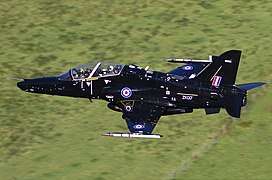 BAE Hawk T2
BAE Hawk T2_at_RIAT_Fairford_13July2017_arp.jpg)
Rotary
In May 2016, it was announced that the RAF would see delivery of 29 Airbus H135 (Juno HT.1) and 3 Airbus H145 (Jupiter HT.1) helicopters for use as training aircraft. It was announced by Air Marshal Sean Reynolds, the Senior Responsible Owner for UKMFTS, that "Aircrew across the three Services will continue to conduct their basic and advanced rotary training at RAF Shawbury and Army Air Corps Middle Wallop. Aircrew selected for training in mountain and maritime helicopter operations will receive instruction at RAF Valley".[221] A further four Jupiter HT.1s were ordered on 21 January 2020.[222]
Symbols, flags, emblems and uniform

Following the tradition of the other British fighting services, the RAF has adopted symbols to represent it, use as rallying devices for members and promote esprit de corps. British aircraft in the early stages of the First World War carried the Union Flag as an identifying feature; however, this was easily confused with Germany's Iron Cross motif. In October 1914, therefore, the French system of three concentric rings was adopted, with the colours reversed to a red disc surrounded by a white ring and an outer blue ring.[223] The relative sizes of the rings have changed over the years and during World War II an outer yellow ring was added to the fuselage roundel. Aircraft serving in the Far East during World War II had the red disc removed to prevent confusion with Japanese aircraft.[224] Since the 1970s, camouflaged aircraft carry low-visibility roundels, either red and blue on dark camouflage, or washed-out pink and light blue on light colours. Most uncamouflaged training and transport aircraft retain the traditional red-white-blue roundel.[224]
The Latin motto of the RAF, "Per ardua ad astra", is usually translated as "Through Adversity to the Stars",[225] but the RAF's official translation is "Through Struggle to the Stars".[3] The choice of motto is attributed to a junior officer named J S Yule, in response to a request from a commander of the RFC, Colonel Sykes, for suggestions.[226]
The Badge of the Royal Air Force was first used in August 1918. In heraldic terms it is: "In front of a circle inscribed with the motto Per Ardua Ad Astra and ensigned by the Imperial Crown an eagle volant and affronte Head lowered and to the sinister".[225] Although there have been debates among airmen over the years whether the bird was originally meant to be an albatross or an eagle, the consensus is that it was always an eagle.[227]
Ceremonial functions and display
Red Arrows
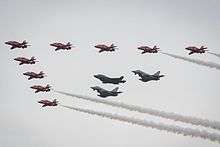
The Red Arrows, officially known as the Royal Air Force Aerobatic Team, is the aerobatics display team of the Royal Air Force based at RAF Scampton, with under-review plans to move to RAF Waddington. The team was formed in late 1964 as an all-RAF team, replacing a number of unofficial teams that had been sponsored by RAF commands.[228] The Red Arrows badge shows the aircraft in their trademark Diamond Nine formation, with the motto Éclat, a French word meaning "brilliance" or "excellence".[228]
Initially, they were equipped with seven Folland Gnat trainers inherited from the RAF Yellowjacks display team. This aircraft was chosen because it was less expensive to operate than front-line fighters. In their first season, they flew at 65 shows across Europe. In 1966, the team was increased to nine members, enabling them to develop their Diamond Nine formation. In late 1979, they switched to the BAE Hawk trainer. The Red Arrows have performed over 4,700 displays in 56 countries worldwide.[229]
Royal Air Force Music
Headquarters Royal Air Force Music Services, located at RAF Northolt, supports professional musicians who attend events around the globe in support of the RAF. The Central Band of the Royal Air Force was established in 1920.[230] Other bands include the Band of the Royal Air Force College, the Band of the Royal Air Force Regiment and the Band of the Royal Auxiliary Air Force.[231]
Current deployments
| Country | Dates | Deployment | Details |
|---|---|---|---|
| Gibraltar | 1940s–present | RAF Gibraltar | Although there are no permanently stationed aircraft, RAF aircraft (e.g. transports) make regular visits.[232] |
| Cyprus | 1940–present | RAF Akrotiri | As part of British Forces Cyprus, the RAF have aircraft which can be deployed from Cyprus as part of the intervention against ISIL.[233] |
| Qatar | 2005–present | RAF Al Udeid | An RAF RC-135 Rivet Joint aircraft is based at Al Udeid which is currently in use as a Middle Eastern base for the RAF as well as being the headquarters for the RAF contribution to Operation Shader.[234] |
| Afghanistan | 2001–present | Operation Toral | The UK continues to contribute to NATO's Resolute Support Mission with the RAF providing Puma HC2s.[235] |
| Norway | 1960s–present | Bardufoss Air Station | RAF fighter and/or helicopter squadrons undergo winter-training in Norway.[236] |
| Ascension Island | 1982–present | RAF Ascension Island | The island is used as an air bridge between the UK and the Falkland Islands.[237] |
| Falkland Islands | 1982–present | RAF Mount Pleasant | As part of British Forces South Atlantic Islands, the RAF has two Chinook helicopters based at Mount Pleasant,[238] and four Typhoon aircraft in an air defence role.[239] |
See also
- List of military aircraft operational during World War II
- List of Royal Air Force stations
- Royal Air Force Air Cadets
- Royal Air Force Museum
- RAF News
Footnotes
- Since April 2013, MoD publications no longer report the entire strength of the Regular Reserve, instead, only Regular Reserves serving under a fixed-term reserve contract are counted. These contracts are similar in nature to the RAuxAF.
References
- "Defence Statistics" (PDF). UK Parliament. 26 September 2014. Archived (PDF) from the original on 21 December 2018. Retrieved 28 December 2018.
- "2018 United Kingdom Military Strength". Global Firepower. Archived from the original on 13 April 2018. Retrieved 12 April 2018.
- "Frequently Asked Questions". Royal Air Force. 2011. Archived from the original on 10 August 2012. Retrieved 15 August 2012.
- "RAF Timeline 1918–1929". Royal Air Force. 2011. Archived from the original on 12 August 2012. Retrieved 15 August 2012.
- Air Power and Colonial Control: The Royal Air Force, 1919–1939 Archived 1 January 2016 at the Wayback Machine By David E. Omissi, Published 1 January 1990, Retrieved 1 February 2014. Page 8.
- BBC: Fact File: The RAF Archived 21 April 2015 at the Wayback Machine, retrieved 1 February 2014
- "Role of the RAF". Royal Air Force. 2011. Archived from the original on 10 August 2012. Retrieved 15 August 2012.
- "Role of Air Power". Royal Air Force. 2011. Archived from the original on 10 August 2012. Retrieved 15 August 2012.
- Nick Harvey, Minister of State for the Armed Forces (31 January 2012). "Military Aircraft". Parliamentary Debates (Hansard). House of Commons. Archived from the original on 17 September 2017. Retrieved 14 April 2019.
- Royal Air Force: Our high-tech gear Archived 3 February 2014 at the Wayback Machine, retrieved 1 February 2014
- "World War I". Royal Air Force. 2011. Archived from the original on 13 August 2012. Retrieved 15 August 2012.
- Dickens, Peter. "The Royal Air Force's 100th Birthday and its founder – Jan Smuts | The Observation Post". Samilhistory.com. Archived from the original on 7 July 2018. Retrieved 13 July 2018.
- "History of Fleet Air Arm Officers Association, FAAOA". Archived from the original on 18 April 2012. Retrieved 22 May 2016.
- Tami Davis Biddle, "British and American Approaches to Strategic Bombing: Their Origins and Implementation in the World War II Combined Bomber Offensive," Journal of Strategic Studies, March 1995, Vol. 18 Issue 1, pp 91–144; Tami Davis Biddle, Rhetoric and Reality in Air Warfare: The Evolution of British and American Ideas about Strategic Bombing, 1914–1945 (2002)
- "RCAF.com : Archives : RCAF History : The War Years". 21 May 2006. Archived from the original on 21 May 2006. Retrieved 22 July 2017.
- "Explore: 'The Angry Sky'". ww2australia.gov.au. Archived from the original on 11 July 2009. Retrieved 29 October 2015.
- "The Few". The Churchill Centre. Archived from the original on 4 March 2012. Retrieved 29 April 2011.
The gratitude of every home in our island, in our Empire, and indeed throughout the world, except in the abodes of the guilty, goes out to the British airmen who, undaunted by odds, unwearied in their constant challenge and mortal danger, are turning the tide of the world war by their prowess and by their devotion. Never in the field of human conflict was so much owed by so many to so few.
- Paul Brickhill, The Dambusters
- "Attack on Amiens Prison, 18th February 1944". RAF. 2004. Archived from the original on 1 January 2007. Retrieved 1 January 2007.
- "RAF Timeline 1945–1949". Royal Air Force. 2011. Archived from the original on 12 August 2012. Retrieved 15 August 2012.
- "RAF Timeline 1960–1969". Royal Air Force. 2011. Archived from the original on 12 August 2012. Retrieved 15 August 2012.
- Burnell, Brian. "Weapon detail and No.15 Squadron data for 1984." Archived 10 October 2017 at the Wayback Machine nuclear-weapons.info. Retrieved 19 January 2011.
- "Strategic Defence Review 1998: Full Report." Archived 26 October 2012 at the UK Government Web Archive Ministry of Defence, 1998, p. 24.
- Air of Authority – A History of RAF Organisation – Overseas Commands – Iraq, India and the Far East Archived 6 August 2008 at the Wayback Machine
- "Operation Firedog : air support in the Malayan Emergency, 1948–1960". Imperial war Museum. Archived from the original on 31 December 2017. Retrieved 31 December 2017.
- "Seletar's Sunderlands". RAF Seletar. Archived from the original on 14 June 2018. Retrieved 31 December 2017.
- "Flight Lieutenant Jack Sherburn: Pilot awarded a DFC for his gallantry against the Mau Mau who went on to serve in Suez and fly with Yuri Gagarin". The Independent. 20 August 2014. Archived from the original on 1 January 2018. Retrieved 31 December 2017.
- "Suez Crisis". Britain's small wars. Archived from the original on 5 February 2009. Retrieved 31 December 2017.
- The Guardian: Britain’s secret wars
- Peterson, J. E. (2 January 2013). Oman's Insurgencies: The Sultanate's Struggle for Supremacy. Saqi. ISBN 9780863567025. Retrieved 29 April 2018 – via Google Books.
- "Confrontation Ends". Straits Times. 12 August 1966. Archived from the original on 31 December 2017. Retrieved 31 December 2017.
- Ashworth 1989, p.26.
- Evans 1998, pp. 74–75.
- "Argentine Aircraft Lost – Falklands War 1982". Naval-history.net. 15 June 1982. Archived from the original on 29 May 2009. Retrieved 23 March 2010.
- "RAF Typhoons arrive for Falkland Islands mission – 9/22/2009". Flight Global. 22 September 2009. Archived from the original on 26 December 2010. Retrieved 19 August 2014.
- Royal Air Force: Expeditionary Air Force Archived 14 February 2014 at the Wayback Machine, raf.mod.uk
- "Gulf War 25th anniversary special: a quick look at the RAF Tornado's reconnaissance missions over Iraq". Aviationist. 17 January 2016. Archived from the original on 31 December 2017. Retrieved 31 December 2017.
- "RAF 'nearly ran out of bombs' in Kosovo". The Guardian. 25 April 2000. Archived from the original on 31 December 2017. Retrieved 31 December 2017.
- Tornados Bound for Kandahar, Air Forces Monthly, August 2008 issue, p. 8.
- "903 Expeditionary Air Wing". Royal Air Force (RAF). Archived from the original on 18 March 2015. Retrieved 21 October 2014.
- "MOD rushes new transport plane into service for operations". The Telegraph. 22 April 2011. Archived from the original on 1 January 2018. Retrieved 31 December 2017.
- "90th Anniversary Flypast in London". RAF News Archives. 1 April 2008. Archived from the original on 16 October 2015. Retrieved 30 October 2015.
- "BBC – Error 404 : Not Found". Archived from the original on 2 April 2008. Retrieved 22 July 2017.
- "Flypast marks RAF's anniversary". BBC News. Archived from the original on 6 April 2008. Retrieved 29 October 2015.
- "Lots of Losers in U.K. Defense Review". DefenseNews. Retrieved 22 October 2010.
- Wilkinson, Tom (24 November 2010). "Last Harrier jet leaves Ark Royal". Independent. UK. Archived from the original on 27 November 2010. Retrieved 4 December 2010.
- "MoD image description". mod.uk. Archived from the original on 16 October 2015. Retrieved 29 October 2015.
- RAF Typhoons intercept Russian bombers Archived 19 February 2014 at the Wayback Machine (flightglobal.com), 27 October 2011
- Hansard Archived 14 June 2018 at the Wayback Machine (publications.parliament.uk), 24 January 2014
- UK Ministry of Defence press release 20 September 2012
- "Farewell to RAF UK Search & Rescue". raf.mod.uk. Archived from the original on 8 December 2015. Retrieved 3 November 2015.
- Allison, George (1 March 2018). "Royal Air Force surveillance satellite launched into space". UK Defence Journal. Archived from the original on 3 March 2018. Retrieved 2 March 2018.
- Corfield, Gareth (1 March 2018). "Brit military boffins buy airtime on HD eye-in-the-sky video satellite". The Register. Archived from the original on 1 March 2018. Retrieved 2 March 2018.
- "Air Command senior, as of September 2018". GOV.UK. Ministry of Defence. 12 March 2020. Retrieved 9 May 2020.
- "Chief of the Air Staff". Royal Air Force. Retrieved 9 May 2020.
- Heyman 2013, p. 134–135.
- "Senior Commanders". Royal Air Force. Retrieved 9 May 2020.
- Heyman 2013, p. 136.
- "RAF High Wycombe". Royal Air Force. Retrieved 9 May 2020.
- "No. 1 Group". Royal Air Force. Retrieved 9 May 2020.
- "No. 2 Group". Royal Air Force. Retrieved 9 May 2020.
- "No. 11 Group". Royal Air Force. Retrieved 9 May 2020.
- "No 22 Group". Royal Air Force. Retrieved 9 May 2020.
- "No. 38 Group". Royal Air Force. Retrieved 9 May 2020.
- "No 83 Expeditionary Air Group". Royal Air Force. Retrieved 9 May 2020.
- Heyman 2013, p. 145.
- "RAF Stations". Royal Air Force. Retrieved 10 May 2020.
- "Quick Reaction Alert". Royal Air Force. Retrieved 10 May 2020.
- "Permanent Joint Operating Bases (PJOBs)". GOV.UK. Ministry of Defence. 12 December 2012. Retrieved 19 July 2017.
- "House of Commons - Hansard Written Answers for 17 March 2014 : Column 493W". parliament.uk. 17 March 2014. Retrieved 19 July 2017.
- "Squadrons". Royal Air Force. Retrieved 10 May 2020.
- "RAF Station organisation". Armed forces. Archived from the original on 24 August 2017. Retrieved 31 December 2017.
- Stone, Trevor (2017). "5". Sustaining Air Power: Royal Air Force Logistics since 1918. Fonthill Media. ISBN 978-1-78155-635-1.
- "Number 34 Expeditionary Air Wing". RAF. Archived from the original on 1 January 2018. Retrieved 31 December 2017.
- "A Special Thank You For RAF Personnel Involved in Op Ruman". Forces Network. 27 October 2017. Archived from the original on 2 January 2018. Retrieved 1 January 2018.
- "RAF Mareham". RAF. Archived from the original on 31 July 2017. Retrieved 31 December 2017.
- "Robert Smith-Barry: The man who taught the world to fly". BBC. 23 February 2013. Archived from the original on 24 October 2018. Retrieved 31 December 2017.
- "Welcome to RAF Shawbury". RAF. Archived from the original on 17 October 2017. Retrieved 31 December 2017.
- "Royal Air Force". Royal Air Force. Archived from the original on 10 September 2017. Retrieved 23 April 2020.
- "New Gliding School Launches for Air Cadets". Air Cadets. Archived from the original on 15 February 2014. Retrieved 14 December 2014.
- "RAF Cranwell". Royal Air Force. Archived from the original on 24 September 2015. Retrieved 23 November 2014.
- "Elementary Flying Training". Royal Navy. Archived from the original on 1 January 2018. Retrieved 31 December 2017.
- "RAF Valley". Royal Air Force. Archived from the original on 28 February 2020. Retrieved 28 February 2020.
- "6 Flying Training School". RAF.mod.uk. Archived from the original on 12 October 2015. Retrieved 8 October 2015.
- "Defence College of Technical Training". RAF. Archived from the original on 30 July 2017. Retrieved 29 July 2017.
- "RAF – Defence College of Technical Training". www.raf.mod.uk. Archived from the original on 4 February 2017. Retrieved 29 December 2016.
- here, RAF Details. "RAF – DSAE". www.raf.mod.uk. Archived from the original on 30 July 2017. Retrieved 29 July 2017.
- here, RAF Details. "RAF – DSEME". www.raf.mod.uk. Archived from the original on 30 July 2017. Retrieved 29 July 2017.
- here, RAF Details. "RAF – DSCIS". www.raf.mod.uk. Archived from the original on 30 July 2017. Retrieved 29 July 2017.
- "History of 1435 Squadron". MOD. Archived from the original on 22 December 2015.
- "Fly-past for Britain's oldest man". BBC News. 3 June 2006. Archived from the original on 30 April 2009. Retrieved 20 April 2011.
- gov.uk MoD – regular personnel Archived 2 April 2015 at the Wayback Machine, table 2-page 8. 1 January 2015.
- gov.uk MoD – quarterly personnel report Archived 21 April 2016 at the Wayback Machine, table 4-page 9. 1 January 2015.
- dasa.mod – reserves and cadet strengths Archived 3 December 2013 at the Wayback Machine, table 4-page 6. April 2012.
- gov.uk MoD – reserves and cadet strengths Archived 8 March 2016 at the Wayback Machine, table 4-page 13. See note 2. April 2014.
- gov.uk MoD – reserves and cadet strengths Archived 8 March 2016 at the Wayback Machine, table 4-page 13. April 2014.
- IISS 2012, pp. 171
- IISS 2012, pp. 111–120
- "RAF IOT Breakdown" (PDF). 9 August 2016. Archived (PDF) from the original on 22 October 2016. Retrieved 22 October 2016.
- "Commissioned ranks of the Royal Air Force 1919–present". Air of Authority – A history of RAF Organisation. Archived from the original on 31 December 2017. Retrieved 31 December 2017.
- "Recruit training". RAF. Archived from the original on 1 January 2018. Retrieved 31 December 2017.
- "Chief of the Air Staff's Warrant Officer". Royal Air Force. 2011. Archived from the original on 12 August 2012. Retrieved 15 August 2012.
- "Royal Air Force Centre for Air Power Studies". Air Power Studies. Archived from the original on 1 January 2018. Retrieved 31 December 2017.
- "Air Warfare Centre". armedforces.co.uk. Archived from the original on 10 February 2012. Retrieved 5 January 2012.
- "Defence Review: inside the college that trains the top brass". Telegraph. 16 September 2010. Archived from the original on 1 January 2018. Retrieved 31 December 2017.
- "Typhoon FGR4". Royal Air Force. Archived from the original on 21 April 2020. Retrieved 24 May 2020.
- Jennings, Gareth (22 September 2014). "RAF Lossiemouth undertakes first QRA North scramble". IHS Jane's Defence Weekly. Archived from the original on 1 February 2015.
- "UK retires last Tornado F3 fighters". Craig Hoyle. Flightglobal. 22 March 2011. Archived from the original on 15 April 2011. Retrieved 22 March 2011.
- Hoyle, Craig (8 November 2018). "The UK Royal Air Force is advancing with preparations to mark the departure from service of its last Panavia Tornado GR4 strike aircraft next March". Flight Global. Archived from the original on 24 January 2019. Retrieved 14 March 2019.
- Lake, Jon (4 February 2019). "RAF Typhoons replace Tornados in Operation 'Shader' armed with Brimstone for first time". Jane's 360. Archived from the original on 7 February 2019. Retrieved 14 March 2019.
- Jennings, Gareth (6 July 2018). "RAF receives first 'Centurion' Typhoons ahead of Tornado retirement". Jane's 360. Archived from the original on 1 March 2019. Retrieved 1 April 2019.
- "Royal Air Force Jets to Patrol Icelandic Skies for NATO". Royal Air Force. 13 November 2019. Retrieved 24 May 2020.
- "Typhoon aircraft relocate to RAF Lossiemouth". www.gov.uk. Archived from the original on 24 November 2015. Retrieved 29 October 2015.
- "RAF Mount Pleasant". Royal Air Force. Archived from the original on 29 March 2019. Retrieved 24 May 2020.
- Warnes, Alan (June 2020). "Reaching for the stars: UK combat air". Air Forces Monthly. Key Publishing Ltd. p. 34.
- Air base in front line fully-armed Archived 14 November 2007 at the Wayback Machine – Salisbury Journal, 29 October 2007
- "UK Tornado fleet to retire in 2019, says BAE". Flightglobal.com. 2 August 2012. Archived from the original on 19 August 2012. Retrieved 4 November 2012.
- "BBC News – RAF Marham base for Joint Strike Fighter". Bbc.co.uk. 25 March 2013. Archived from the original on 28 May 2013. Retrieved 8 July 2013.
- tweet_btn(), Gareth Corfield 19 May 2017 at 14:44. "Blighty's buying another 17 F-35s, confirms the American government". Archived from the original on 6 August 2017. Retrieved 22 July 2017.
- "F-35B Lightning". Royal Air Force. Archived from the original on 22 March 2019. Retrieved 1 April 2019.
- "17(R) Squadron". Royal Air Force. Archived from the original on 28 October 2016. Retrieved 1 April 2019.
- "RAF's legendary Dambusters squadron reforms to fly F-35 jets | Royal Air Force". Raf.mod.uk. 18 April 2018. Archived from the original on 15 August 2018. Retrieved 15 August 2018.
- Taz Ali. "F-35 Lightning fighter jets arrive at RAF Marham | Latest Norfolk and Suffolk News – Eastern Daily Press". Edp24.co.uk. Archived from the original on 15 August 2018. Retrieved 15 August 2018.
- "Further five F-35 fighter jets land at new RAF Marham home". ITN News. Archived from the original on 4 August 2018. Retrieved 4 August 2018.
- "First F-35 jets ready to battle for Britain". Archived from the original on 11 January 2019. Retrieved 11 January 2019.
- "Identity of F-35 Lightning Training Squadron Announced". Royal Air Force. 5 July 2017. Archived from the original on 28 July 2017. Retrieved 1 April 2019.
- "Second Lightning Fight Jet Squadron Arrives In UK". www.raf.mod.uk. 17 July 2019. Retrieved 20 January 2020.
- "E-3D". Royal Air Force. Retrieved 28 February 2020.
- "RAF Sentry AEW aircraft deploys in support of counter-IS mission". Flight Global. Archived from the original on 2 February 2015. Retrieved 2 February 2015.
- "AWACS For United Kingdom and France". Boeing. Archived from the original on 10 October 2012. Retrieved 28 February 2020.
- "Displaying Serials in range ZH". ukserials.com. Retrieved 28 February 2020.
- "The Future of Air C2 and AEW: E-3 Sentry, Threat Technologies and Future Replacement Options". Royal United Services Institute. 5 June 2017. Retrieved 28 February 2020.
- "WEDGETAIL TO BE RAF'S NEW EARLY WARNING RADAR AIRCRAFT". Royal Air Force. 22 March 2019. Archived from the original on 22 March 2019. Retrieved 22 March 2019.
- "Ministry of Defence: The Equipment Plan 2019 to 2029" (PDF). National Audit Office. 27 February 2020. Retrieved 28 February 2020.
- "Sentinel R1". Royal Air Force. Retrieved 28 February 2020.
- "Raytheon Signs Contract For U.K. ASTOR Program". Aviation Week. 20 December 1999. Retrieved 28 February 2020.
- "ASTOR Enters Service in U.K." Raytheon. 1 December 2008. Retrieved 28 February 2020.
- "Raytheon Delivers Final Sentinel R Mk 1 Aircraft for U.K. ASTOR System". Defence Aerospace. 10 February 2009. Retrieved 28 February 2020.
- "Securing Britain in an Age of Uncertainty: The Strategic Defence and Security Review" (PDF). HM Government. 19 October 2010. Retrieved 28 February 2020.
- "PM announces £1.1bn defence spending". BBC News. 14 July 2014. Retrieved 28 February 2020.
- Allison, George (17 July 2017). "Sentinel fleet cut by one aircraft but gains reprieve until 2021". UK Defence Journal. Retrieved 28 February 2020.
- "Shadow R1". Royal Air Force. Retrieved 28 February 2020.
- "UK TO ACQUIRE TWO MORE BEECHCRAFT KING AIR 350-DERIVED SHADOW R.1". King Air Nation. 27 November 2015. Retrieved 28 February 2020.
- "UK converts King Air 350s into ISTAR platforms". defence-solutions.co.uk. 13 January 2009. Archived from the original on 14 April 2009. Retrieved 16 February 2009.
- "Military Aircraft Markings Update number 49, June 2009" (PDF). Military Aircraft Markings. Retrieved 28 February 2020.
- "New defensive aids for RAF Shadow ISTAR fleet". Air Forces Monthly. 16 September 2019. Retrieved 28 February 2020.
- "14 Squadron". Royal Air Force. Archived from the original on 2 February 2017. Retrieved 28 February 2020.
- "National Security Strategy and Strategic Defence and Security Review 2015" (PDF). www.gov.uk. HM Government. Archived (PDF) from the original on 24 November 2015. Retrieved 26 November 2015.
- "Armed drones operated from RAF base in UK, says MoD". BBC News. 27 April 2013. Archived from the original on 28 April 2013. Retrieved 27 April 2013.
- "RC-135W Rivet Joint". Royal Air Force. Retrieved 28 February 2020.
- "Nimrod R1 aircraft in final flight for RAF". BBC News. 28 June 2011. Archived from the original on 1 July 2011. Retrieved 1 July 2011.
- Ministry of Defence (22 December 2010). "Rivet Joint joins Future Force 2020". Mod.uk. Archived from the original on 19 October 2012. Retrieved 13 September 2013.
- "Iraq: 'Secret' Surveillance Flights Revealed". Sky News. 16 November 2014. Archived from the original on 28 January 2015. Retrieved 29 December 2014.
- "54 Squadron". raf.mod.uk. Royal Air Force. Retrieved 26 May 2020.
- "56 Squadron". raf.mod.uk. Royal Air Force. Retrieved 26 May 2020.
- "Strategic Defence Review" (PDF). Ministry of Defence. 1 July 1998. Archived (PDF) from the original on 19 April 2016. Retrieved 30 December 2017.
- "22 Squadron Re-Forms At RAF Benson". Royal Air Force. 14 May 2020. Retrieved 26 May 2020.
- Baldwin, Harriett (7 December 2017). "Chinook Helicopters: Written question – 116751". UK Parliament. Archived from the original on 11 December 2017. Retrieved 10 December 2017.
- "Boeing Unit to Make Helicopters for U. K. In $200 Million Job". The Wall Street Journal. 9 February 1978. Archived from the original on 5 June 2011. Retrieved 26 May 2020.
- "COMPANY NEWS; BOEING AND WESTLAND SPLIT BRITISH HELICOPTER ORDER". The New York Times. 10 March 1995. Retrieved 26 May 2020.
- "RAF flying high in new Chinook helicopters". gov.uk. Ministry of Defence. 16 June 2014. Retrieved 26 May 2020.
- "United Kingdom – H-47 Chinook (Extended Range) Helicopters and Accessories". United States Defense Security Cooperation Agency. 19 October 2018. Retrieved 26 May 2020.
- "Chinook". Royal Air Force. Retrieved 26 May 2020.
- "RAF Squadrons Receive Battle Honours from Her Majesty The Queen". Royal Air Force. 24 March 2020. Retrieved 26 May 2020.
- "Hurricane Irma Relief". Royal Air Force. Retrieved 26 May 2020.
- Tanguy, Jean-Marc (June 2020). "Airlifters in Africa". Air Forces Monthly. Key Publishing Ltd. pp. 54–57.
- "Final new-build Chinook HC6s delivered to UK RAF". Flight Global. 10 December 2015. Retrieved 26 May 2020.
- Baldwin, Harriett (7 December 2017). "Chinook Helicopters: Written question – 116751". UK Parliament. Retrieved 26 May 2020.
- "230 Squadron". NATO Tigers. Retrieved 26 May 2020.
- "UK MoD receives first upgraded Puma HC Mk2 helicopter". Airforce Technology. 14 September 2012. Archived from the original on 6 July 2015. Retrieved 23 April 2015.
- "Wildcat Workout". Flight International. 99 (3230): 532. 4 February 1971.
- "RAF using Argentine aircraft from Falklands War". Merco Press. 11 June 2001. Retrieved 26 May 2020.
- Dubois, Paul. "Puma SA 330 in SAAF Service". TRANSPORT IN SOUTH and SOUTHERN AFRICA. Retrieved 26 May 2020.
- "Upgraded Puma fleet reaches 10,000 flight hours". Airbus. 24 March 2016. Retrieved 26 May 2020.
- "Support deal worth £100m agreed for Puma helicopters". gov.uk. Ministry of Defence. 9 January 2018. Retrieved 26 May 2020.
- "Griffin HAR.2". RAF. Archived from the original on 1 January 2018. Retrieved 31 December 2017.
- "RAF Search and Rescue Force Disbandment Parade". Royal Air Force. 18 February 2016. Archived from the original on 25 February 2016. Retrieved 26 May 2020.
- "202 Squadron". Royal Air Force. Retrieved 26 May 2020.
- "Agusta A109E". RAF. Archived from the original on 1 January 2018. Retrieved 31 December 2017.
- Allison, George (22 August 2018). "RAF announce that the P-8A Maritime Patrol Aircraft will be 'Poseidon MRA Mk1' in UK service". UK Defence Journal. Archived from the original on 22 March 2019. Retrieved 22 March 2019.
- "Defence review: Main developments at a glance". BBC News. 23 November 2015. Archived from the original on 24 November 2015. Retrieved 23 November 2015.
- "Defence Secretary announces new Maritime Patrol Aircraft squadrons". mod.uk. Ministry of Defence. 13 July 2017. Retrieved 10 February 2020.
- "POSEIDON, THE UK'S NEW MARITIME PATROL AIRCRAFT, TAKES TO THE SKIES". Royal Air Force. 13 July 2019. Retrieved 14 July 2019.
- "New Poseidon Maritime Patrol Aircraft lands in UK for first time". raf.mod.uk. Royal Air Force. 4 February 2020. Retrieved 10 February 2020.
- Pike, John. "Royal Air Force to Acquire 7th Boeing C-17 Globemaster III". Globalsecurity.org. Archived from the original on 23 December 2009. Retrieved 22 October 2010.
- "UK to buy eighth C-17 transport". Flight International. 8 February 2012. Archived from the original on 13 February 2012. Retrieved 9 March 2012.
- "New RAF C-17 aircraft touches down in the UK". Ministry of Defence. 24 May 2012. Archived from the original on 9 March 2014. Retrieved 12 June 2013.
- "Voyager, biggest plane in RAF history, arrives in UK". BBC News. 19 April 2011. Archived from the original on 20 April 2011. Retrieved 20 April 2011.
- "Airbus Military's A330 MRTT begins its service career with the UK Royal Air Force". Airbus. 9 April 2012. Archived from the original on 13 November 2013. Retrieved 12 June 2013.
- Hoyle, Craig (21 May 2013). "RAF Voyager launches tanker operations with Tornado". Flight International. Archived from the original on 9 June 2013. Retrieved 12 June 2013.
- Curtis, Howard J. (2019). Military Aircraft Markings 2019. Manchester: Crécy Publishing Ltd. p. 93. ISBN 978-1-91080-925-9. Retrieved 11 February 2020.
- "RAF, USAF Work on Rivet Joint Refueling Deal". Aviationweek.com. 5 July 2013. Archived from the original on 14 November 2013. Retrieved 13 September 2013.
- "Service Inquiry into the accident involving a Hercules C-130J Mk4 (ZH873) Heavy Landing Incident on 25 August 2017". gov.uk. Ministry of Defence. 21 May 2019. Retrieved 11 February 2020.
- Jennings, Gareth (24 July 2019). "UK extends Hercules out-of-service date to 2035". Jane's 360. London. Retrieved 11 February 2020.
- "MOD signs contracts and agreements for new RAF aircraft and weapons". Ministry of Defence. Archived from the original on 2 April 2010. Retrieved 14 April 2010.
- "Hercules Aircraft:Written question – 4690". UK Parliament. 21 July 2017. Archived from the original on 30 July 2017. Retrieved 30 July 2017.
- "BAE Systems wins £15.5 million MOD contract for the Royal Air Force". BAE Systems. 21 June 2012. Archived from the original on 4 February 2013. Retrieved 25 June 2012.
- "BAe 146 C.Mk 3 aircraft delivered to the UK Royal Air Force". BAE Systems. 19 April 2013. Archived from the original on 9 March 2014. Retrieved 12 June 2013.
- "BAe146 C Mk 3". Royal Air Force. 29 April 2013. Archived from the original on 30 May 2013. Retrieved 12 June 2013.
- "Royal Air Force". Royal Air Force. Retrieved 4 May 2020.
- "Operational conversion". RAF. Archived from the original on 1 January 2018. Retrieved 31 December 2017.
- Brown, David (11 May 2018). "RAF grounds its training gliders over safety fears". The Times (72532). p. 4. ISSN 0140-0460.
- "Fixed-wing Light Aircraft Training System – Contracts Finder". Contractsfinder.service.gov.uk. Archived from the original on 16 November 2018. Retrieved 26 February 2018.
- "First T-6C Texan IIs arrive at Valley". Air Forces Monthly (361): 8. April 2018.
- "100 Squadron". RAF. Archived from the original on 14 June 2018. Retrieved 30 May 2018.
- "U.K. Makes F-35 U-Turn to Cut Costs, Narrow Carrier-Defense Gap." Archived 5 December 2014 at the Wayback Machine Bloomberg News, 10 May 2012.
- Prince of Wales aircraft carrier ‘makes little sense’ without aircraft to fly from it Archived 7 January 2017 at the Wayback Machine, The Guardian. Retrieved 25 October 2015.
- Defence Review: Fighting old battles? Archived 27 June 2018 at the Wayback Machine, BBC News. Retrieved 26 November 2015.
- "First RAF F-35B stealth fighter jet lands in UK". BBC News. 30 June 2016. Archived from the original on 30 June 2016. Retrieved 30 June 2016.
- "'Protector' UAV fleet to replace RAF Reapers". Flightglobal. 5 October 2015. Archived from the original on 8 October 2015. Retrieved 7 October 2015.
- "MoD reveals Reaper derivative will be chosen for Protector". Flightglobal. 7 October 2015. Archived from the original on 8 December 2015. Retrieved 7 October 2015.
- Stevenson, Beth (18 November 2016). "US approves sale of up to 26 Protector UAVs to UK | News". Flight Global. Retrieved 25 May 2020.
- "Key Battle of Britain Fighter Command group to be reformed". St Helens Star. Newsquest Media Group. 11 July 2018. Archived from the original on 11 July 2018. Retrieved 12 July 2018.
- "Protector makes its way to the UK". Royal Air Force. 11 July 2018. Archived from the original on 12 July 2018. Retrieved 12 July 2018.
- "RAF announces new Typhoon, Protector squadrons". IHS Janes. 12 July 2018. Archived from the original on 12 July 2018. Retrieved 13 July 2018.
- "UK sets out post-2030 combat aviation force structure". Janes. 29 July 2014. Archived from the original on 20 August 2014. Retrieved 10 May 2015.
- Callum Jones, Trade Correspondent, at Farnborough. "RAF unveils £2bn plan for new Tempest fighter jet (and it has lasers) | News". The Times. Archived from the original on 17 July 2018. Retrieved 17 July 2018.CS1 maint: multiple names: authors list (link)
- Quin, Jeremy (11 May 2020). "AWACS:Written question - 41916". UK Parliament. Retrieved 12 May 2020.
- "UK Military Flying Training System fixed wing contract achieves financial close". Mott MacDonald. 17 February 2016. Archived from the original on 14 June 2018. Retrieved 31 December 2017.
- "Hawk T2". RAF. Archived from the original on 19 May 2018. Retrieved 30 May 2018.
- "New helicopter deal boosts UK's investment in military flying training to £2.8 billion". 20 May 2016. Archived from the original on 22 October 2016. Retrieved 22 October 2016.
- "£183 million boost for military helicopter training". gov.uk. Ministry of Defence. 21 January 2020. Retrieved 21 January 2020.
- Robertson 1967, p 89
- "The RAF Roundel". RAF. Archived from the original on 4 July 2017. Retrieved 31 December 2017.
- Air Ministry Orders A.666/49, 15 September 1949
- "The Royal Air Force Motto". RAF. Archived from the original on 1 December 2017. Retrieved 31 December 2017.
- W/C F.H. Hitchins. "It's an albatross, it's an eagle ... it's an eagle". Forces.gc.ca. Archived from the original on 9 June 2011. Retrieved 22 October 2010.
- "Team History". Royal Air Force Arrows. Archived from the original on 3 July 2017. Retrieved 31 December 2017.
- "Red Arrows". Royal Air Force. Archived from the original on 3 July 2017. Retrieved 7 August 2016.
- "Central Band of the Royal Air Force". Archived from the original on 3 July 2017. Retrieved 31 December 2017.
- "RAF – The Band of the Royal Auxiliary Air Force". www.raf.mod.uk. Archived from the original on 29 December 2016. Retrieved 29 December 2016.
- "The History of RAF Gibraltar". RAF. Archived from the original on 1 January 2018. Retrieved 31 December 2017.
- "British pilots took part in anti-Isis bombing campaign in Syria". The Guardian. 17 July 2015. Archived from the original on 1 January 2018. Retrieved 31 December 2017.
- "The brand new RAF Rivet Joint aircraft "fried" Daesh communications with massive jamming attack in Libya". The Aviationist. 19 May 2016. Archived from the original on 1 January 2018. Retrieved 31 December 2017.
- "The British Army – Joint Helicopter Command". www.army.mod.uk. Archived from the original on 14 January 2017. Retrieved 30 December 2016.
The JHC's current deployment in Afghanistan is with the Puma Mk2 which is providing a vital lift capability to the NATO Resolute Support mission in Kabul.
- "Norwegian Arctic training for UK forces helicopter crews". Ministry of Defence. 19 March 2015. Archived from the original on 1 January 2018. Retrieved 31 December 2017.
- Eklund, Dylan (2015). "A rock and a hard place". The Official Royal Air Force Review 2015: 118. ISSN 1758-9681.
- "Britain to boost Falklands Islands defences". BBC. 24 March 2015. Archived from the original on 16 November 2017. Retrieved 31 December 2017.
- Farmer, Ben (24 March 2015). "Britain's military defences in the Falkland Islands". The Telegraph. Archived from the original on 6 March 2019. Retrieved 3 March 2019.
Bibliography
- Biddle, Tami Davis. Rhetoric and Reality in Air Warfare: The Evolution of British and American Ideas about Strategic Bombing, 1914–1945 (2002)
- Bowyer, Chaz. History of the RAF (London: Hamlyn, 1977).
- Dean, Maurice. The Royal Air Force and Two World Wars (Cassell, 1979).
- Connolly, Corvin J. Marshal of the Royal Air Force Sir John Cotesworth Slessor and the Anglo-American Air Power Alliance, 1940–1945 (Texas A&M Press, 2001).
- Cox, Jafna L. "A splendid training ground: the importance to the Royal Air Force of its role in Iraq, 1919–32." Journal of Imperial and Commonwealth History 13.2 (1985): 157–184.
- Davis, Richard B. Bombing the European Axis Powers. A Historical Digest of the Combined Bomber Offensive 1939–1945 (Air University Press, 2006) online
- Gooderson, Ian. Air Power at the Battlefront: Allied Close Air Support in Europe 1943–45 (Routledge, 2013).
- Heaton, Colin D., and Anne-Marie Lewis. Night Fighters: Luftwaffe and RAF Air Combat Over Europe, 1939–1945 (Naval Institute Press, 2008).
- Heyman, Charles (2013). The Armed Forces of the United Kingdom (2014–2015). Barnsley: Pen and Sword. ISBN 178346351-1.
- Hoffman, Bruce. British Air Power in Peripheral Conflict, 1919–1976 (RAND, 1989) online, with bibliography
- International Institute for Strategic Studies; Hackett, James (ed.) (2010). The Military Balance 2010. London: Routledge. ISBN 978-1857435573.CS1 maint: extra text: authors list (link)
- International Institute for Strategic Studies; Hackett, James (ed.) (2012). The Military Balance 2012. London: Routledge. ISBN 978-1857436426.CS1 maint: extra text: authors list (link)
- Lee, David. Eastward: a history of the Royal Air Force in the Far East, 1945-1972 (Seven Hills Books, 1984).
- Lee, David. Flight from the Middle East: A History of the Royal Air Force in the Arabian Peninsula and Adjacent Territories, 1945–1972 (HM Stationery Office, 1980).
- Maiolo, Joseph. Cry Havoc: How the arms race drove the world to war, 1931–1941 (2010)
- Philpott, Ian, ed. Royal Air Force History: Royal Air Force – an Encyclopaedia of the Inter-War Years (2 vol 2008)
- Rawlings, John D.R. The History of the Royal Air Force (1984) well illustrated.
- Richards, Denis, and David Pilgrim. Royal Air Force, 1939–1945: The fight at odds (1954), the official history.
- Robertson, Bruce (1967). Aircraft Markings of the World 1912–1967. London: Harleyford. ISBN 978-0900435096.
- Saunders, Hilary. Per Ardua: The Rise of British Air Power, 1911-1939 (Oxford UP, 1945).
- Sinnott, Colin S. The RAF and Aircraft Design: Air Staff Operational Requirements 1923-1939 (Routledge, 2014).
- Smith, Malcolm. British Air Strategy Between the Wars (Oxford, The Clarendon Press, 1984).
- Smith, Gordon Scott. RAF War Plans and British Foreign Policy 1935 - 1940 (MIT Dept. of Political Science, 1966). online
- Werrell, Kenneth P. "The strategic bombing of Germany in World War II: Costs and accomplishments." Journal of American History 73.3 (1986): 702–713. online
External links
| Wikimedia Commons has media related to Royal Air Force. |
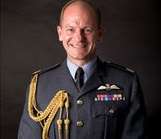


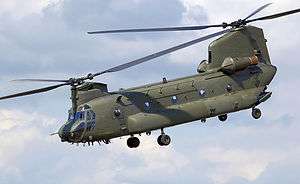
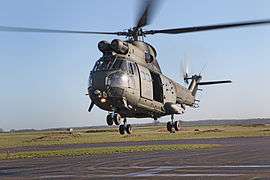
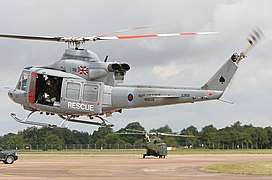
.jpg)
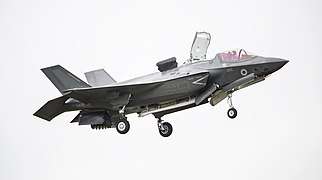
.jpg)
.jpg)
.jpg)
.jpg)